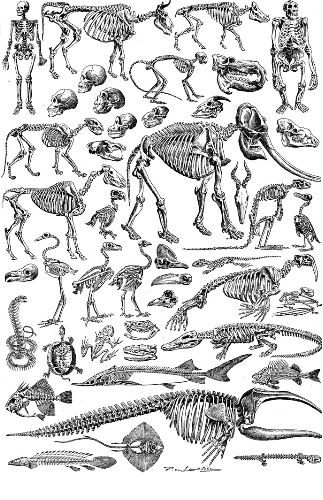Endoskeleton

| Part of a series related to |
| Biomineralization |
|---|
 |
Anendoskeleton(From Greek ἔνδον, éndon = "within", "inner" + σκελετός, skeletos = "skeleton" ) is astructural frame(skeleton) on the inside of ananimal,overlaid bysoft tissuesand usually composed ofmineralized tissue.[1][2]Endoskeletons serve asstructural supportagainstgravityandmechanical loads,and provide anchoring attachment sites forskeletal musclesto transmit force and allow movements and locomotion.
Vertebratesand the closely relatedcephalochordatesare the predominant animalcladewith endoskeletons (made of mostlyboneand sometimescartilage), althoughinvertebratessuch asspongesalso have evolved a form of endoskeletons made of diffuse meshworks ofcalcite/silicastructural elementscalledspicules,andechinodermshave adermalcalcite endoskeleton known asossicles.Somecoleoidcephalopods(squidsandcuttlefish) have an internalizedvestigialaragonite/calcite-chitinshellknown asgladiusorcuttlebone,which can serve as muscle attachments but the main function is often to maintainbuoyancyrather than to give structural support, and their body shape is largely maintained byhydroskeleton.
Compared to theexoskeletonsof many invertebrates, endoskeletons allow much larger overall body sizes for the same skeletalmass,as most soft tissues andorgansare positionedoutsidethe skeleton rather than within it. Being more centralized in structure also means more compactvolume,making it easier for thecirculatory systemtoperfuseandoxygenate,as well as highertissuedensityagainststress.The external nature of muscle attachments also allowsthickerand more diversemuscle architectures,as well as more versatilerange of motions.
Overview[edit]
An endoskeleton is a skeleton that is on the inside of a body, like humans, dogs, or some fish. The endoskeleton develops within the skin or in the deeper body tissues. The vertebrate endoskeleton is basically made up of two types of tissues (boneandcartilage). During early embryonic development the endoskeleton is composed ofnotochordand cartilage. The notochord in most vertebrates is replaced by the vertebral column and cartilage is replaced by bone in most adults. In threephylaand onesubclassof animals, endoskeletons of various complexity are found:Chordata,Echinodermata,Porifera,andColeoidea.An endoskeleton may function purely for support (as in the case ofsponges), but often serves as an attachment site for muscle and a mechanism for transmitting muscular forces. A true endoskeleton is derived frommesodermaltissue. Such askeletonis present in echinoderms and chordates. The poriferan "skeleton" consists of microscopic calcareous or siliceousspiculesor asponginnetwork. The Coleoidea do not have a true endoskeleton in the evolutionary sense; there, amolluskexoskeletonevolvedinto several sorts of internal structure, the "cuttlebone" ofcuttlefishbeing the best-known version. Yet they do have cartilaginous tissue in their body, even if it is not mineralized, especially in the head, where it forms a primitive cranium. The endoskeleton gives shape, support, and protection to the body and provides a means of locomotion.

-
Ahuman skeletonon display atBooth Museum of Natural History
-
Fossilizedskeleton of variousdinosaurs
-
The skeleton of akitefin shark,acartilaginous fish
-
The dermal ossicles of astarfish,an echinoderm
-
The silica spicule skeleton of aVenus' flower basket,aglass sponge
See also[edit]
References[edit]
- ^Hyman, Libbie Henrietta (1992-09-15).Hyman's Comparative Vertebrate Anatomy.University of Chicago Press. pp. 192–236.ISBN978-0-226-87013-7.
- ^Gillis, J. Andrew (2019),"The Development and Evolution of Cartilage",Reference Module in Life Sciences,Elsevier,doi:10.1016/b978-0-12-809633-8.90770-2,ISBN978-0-12-809633-8,retrieved2023-10-03





